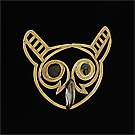Curriculum links Design/Tech
Metalwork
Chavín metalsmiths demonstrated the sophisticated working of metal in South America. Gold dust and nuggets were originally washed from riverbeds and beaten into thin sheets. One gram of gold could be hammered into a sheet as large as one square metre. The rectangular shape was then cut with a knife and worked using a variety of techniques. Chan Chan was the centre of the Chimú workshops, which produced more metal objects than any other Peruvian culture. Chimú smiths preferred silver to gold. In ancient Peru gold and silversmiths were perceived as direct intermediaries between the gods and humans. They were also familiar with complex processes that could transform the elements of nature into dazzling objects in the image of the gods. These craftsmen were often buried in privileged places along with their sacred tools.
- Research the symbolism of gold and silver in ancient Andean cultures. Why was duality such an important aspect of cultural life? Investigate why the Chimú metalsmiths preferred to make objects from silver instead of gold.
- There are a number of gold beakers in the Gold and the Incas exhibition. Up to 200 were discovered in one tomb at Batán Grande, an important Sicán site. What function did these beakers have during rituals?
- What is the repoussé technique? How would you use this technique to make metal objects?
- Research the positive and negative properties of the mineral cinnabar which was used widely in ritual in ancient Andean culture.
- Textiles were the most symbolic objects in ancient Peru. Which objects did the Spanish conquistadors consider to be more valuable and why was this so?
- How did the Chimú metalsmiths influence the design and production of metal objects in the Inca culture?
- What methods of production were used to make gold objects in ancient Peru?
- Design and fashion a composite animal shaped out of recycled wire and metal using animal shapes in the Gold and the Incas exhibition as your inspiration. How does your design reflect Andean ways of interpreting the world?
- Examine the Chimú ear ornaments in the exhibition. Consider the symbolism of all elements of the design. Design a pair of ear ornaments with multiple movable parts incorporating motifs from the Gold and the Incas exhibition. How difficult is it to work with such small movable parts? Discuss the environmental and technical considerations that would have restricted the creative possibilities for Chimú metalsmiths.
- Using the repoussé technique design and make a pair of hands or a metal beaker as used in ritual ceremonies in ancient Peru. Choose motifs inspired by the Sicán-Lambayeque culture. Consider how your completed hands or beaker compare with those examples in the Gold and the Incas exhibition.
- Design an item of jewellery using the Gold and the Incas exhibition as an inspiration. You may like to design something that is quite simple such as the Chimú pectoral or a more intricate piece such as the Chimú silver nose ornament. Evaluate the visual impact of your creation.
- Design and produce a crown ornament inspired by the gold feather Sicán-Lambayeque example. (hyperlink to entry- IRN 236073) How was feather ornamentation viewed in ancient Peru and why do you think this was so?






